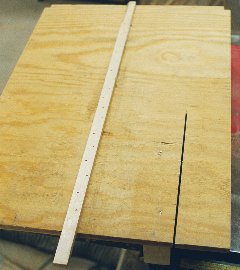I wanted a quick and highly repeatable way to cut scarf joints for the chine, sheer and battens. The methods listed in the books (hand saw, router jig, hand plane, etc) did not appeal to me. I wanted to do the cuts on the table saw.
This sled is modeled after a cross cut sled, but with a pair of fences added for positioning the stock. All of the wood is from the scrap bin.

|
The angled fence and the wedge are from a 2x4 which had its edge jointed to square it up. The 2x4 was cut for an 8:1 slope as recommended in the plans. The wedge fence was glued and clamped while checking that it was absolutely square in the vertical direction. The wedge fence is shown with a bracing block which holds the thin end of the wedge fence vertical. The other fence to the right is used for clamping. Remember to save the off-cut from the wedge fence for use as the clamping wedge. The pencil marks are from a previous use of the plywood scrap and serve no purpose here. |
|
|
|

|
|

|
Chine piece ready for cut. The clamping wedge is shown being tapped into position with the hammer. The firm clamping is VERY important for repeatability. The far end is supported by a helper, my son David, or by a board clamped vertically in the Work Mate. The top edge of the clamped board is at the same height as the top of the sled on the table saw. |
|
| Here the cut is shown in progress. Note the scars in the clamp wedge from previous cuts. You want to make sure that the saw goes completely through the batten so there is not a "nub" sticking out for later trimming by hand. A major feature of the clamping setup is to allow you to keep your hands well clear of the blade. Remember, the saw guard is off for this procedure as well as the kick back pawls. Wear safety glasses and stand to the side. The off cut wedge pieces can become very sharp projectiles! |

|
|